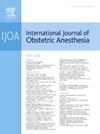意外硬膜穿刺后预防性使用复方新诺明与硬膜穿刺后头痛和硬膜外血贴使用的发生率:一项回顾性队列研究(2019-2022年)。
IF 2.6
3区 医学
Q2 ANESTHESIOLOGY
引用次数: 0
摘要
背景:有研究认为,考昔洛芬可通过增加脑脊液的分泌来降低硬膜穿刺后头痛(PDPH)的发生率。本研究探讨了预防性注射可塞托品与 PDPH 发生率的关系,以及在意外硬膜穿刺(UDP)后使用硬膜外血补片治疗 PDPH 的方法:我们对在实施神经轴向分娩镇痛时发生硬膜外穿刺的病例进行了一项回顾性队列研究。根据医疗机构的惯例,麻醉医师可酌情静脉注射 1 毫克复方新诺明用于预防 PDPH。记录了 PDPH、从 UDP 到使用缩宫素的时间、出现 PDPH 的时间以及硬膜外血贴的处理情况:在 234 例 UDP 病例中,164 例(70%)使用了肌松蛋白。98/164(60%)例患者使用了复方安宫黄体酮,45/70(64%)例患者未使用复方安宫黄体酮(P = 0.66)。调整后的 PDPH 发生率为:使用复方新诺明的 53%,未使用复方新诺明的 62%,差异为 9% (95% CI -6% to 24%, p = 0.25)。调整后的硬膜外血补丁使用率为:使用复方新诺明的 66%,不使用复方新诺明的 78%,差异为 12%(95% CI -5%至 28%,P = 0.17):UDP后预防性使用考昔洛芬与PDPH发生率的显著下降或使用硬膜外血贴治疗PDPH无关。接受或未接受复方甘草酸苷的患者在高血糖或高血压不良事件的发生率上没有明显差异。本文章由计算机程序翻译,如有差异,请以英文原文为准。
Prophylactic cosyntropin after unintentional dural puncture and incidence of post-dural puncture headache and epidural blood patch use: A retrospective cohort study (2019–2022)
Background
Cosyntropin has been suggested to decrease the incidence of post-dural puncture headache (PDPH) by increasing the production of cerebrospinal fluid. This study examined the association of prophylactic cosyntropin administration with the incidence of PDPH and its management with an epidural blood patch after an unintentional dural puncture (UDP).
Methods
We conducted a retrospective cohort study of cases with UDP during placement of neuraxial labor analgesia. Per institutional practice and at the discretion of the anesthesiologist, intravenous cosyntropin 1 mg may be administered for PDPH prophylaxis. PDPH, time from UDP to cosyntropin administration, time to development of PDPH, and management with epidural blood patch(es) were recorded.
Results
Cosyntropin was administered in 164 of 234 (70%) cases with UDP. PDPH occurred 98/164 (60%) with cosyntropin and 45/70 (64%) without cosyntropin (p = 0.66). The PDPH adjusted incidence was 53% with cosyntropin and 62% without cosyntropin, difference 9% (95% CI −6% to 24%, p = 0.25). The adjusted epidural blood patch rate was 66% with cosyntropin and 78% without cosyntropin, difference of 12% (95% CI −5% to 28%, p = 0.17).
Conclusions
Prophylactic cosyntropin following UDP was not associated with a significant decrease in PDPH rate or use of epidural blood patch for management of PDPH. There was no significant difference in the rate of adverse hyperglycemic or hypertensive events amongst those who did or did not receive cosyntropin.
求助全文
通过发布文献求助,成功后即可免费获取论文全文。
去求助
来源期刊
CiteScore
4.70
自引率
7.10%
发文量
285
审稿时长
58 days
期刊介绍:
The International Journal of Obstetric Anesthesia is the only journal publishing original articles devoted exclusively to obstetric anesthesia and bringing together all three of its principal components; anesthesia care for operative delivery and the perioperative period, pain relief in labour and care of the critically ill obstetric patient.
• Original research (both clinical and laboratory), short reports and case reports will be considered.
• The journal also publishes invited review articles and debates on topical and controversial subjects in the area of obstetric anesthesia.
• Articles on related topics such as perinatal physiology and pharmacology and all subjects of importance to obstetric anaesthetists/anesthesiologists are also welcome.
The journal is peer-reviewed by international experts. Scholarship is stressed to include the focus on discovery, application of knowledge across fields, and informing the medical community. Through the peer-review process, we hope to attest to the quality of scholarships and guide the Journal to extend and transform knowledge in this important and expanding area.

 求助内容:
求助内容: 应助结果提醒方式:
应助结果提醒方式:


